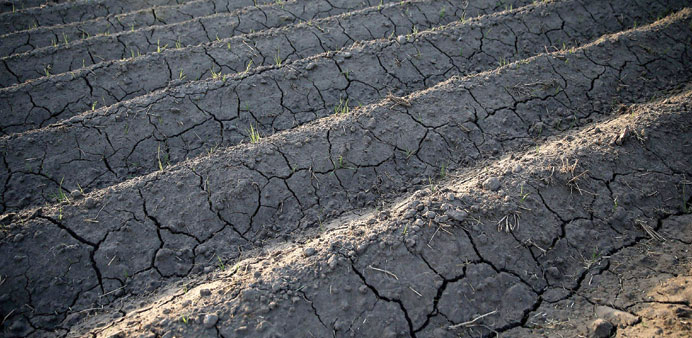Dry cracked earth is visible on a fallow field in Tulare, California. As California enters its fourth year of severe drought, farmers in the Central Valley are struggling to keep crops watered as wells run dry and government water allocations have been reduced or terminated. Many have opted to leave acres of their fields fallow.
By David Hasemyer/TNS/Los Angeles
When Guleed Ali hikes the nooks and crannies of stream-sculpted canyons that lead to Mono Lake in central California, he often pauses to marvel at the landscape that spreads out before him.
He ponders the smooth blue lake that reflects the snow-capped Sierra Nevada and the limestone spires that reach skyward like fingers beckoning the birds.
But the young scientist looks beyond the grandeur. He also seeks clues to California’s historic drought.
Since 2010, Ali, 28, has been studying sediment surrounding Mono Lake, which sits at the base of the eastern Sierra Nevada Mountains and near the edge of Yosemite National Park, looking for evidence of past droughts found sandwiched in the layers of deposits that have been laid down over the ages.
Trekking the canyons that lead to Mono Lake, Ali has mapped layers of sediments far above its current shoreline and removed samples for analysis.
In the lab, Ali has begun analysing the layers using sophisticated dating techniques that allow him to plot how the lake level has risen and fallen over 27,000 years. He will then use existing data of known carbon dioxide and methane levels along with solar radiation levels to determine the atmospheric conditions at the time each layer of sediment was deposited.
Ali, a Ph.D. candidate at Lamont-Doherty Earth Observatory, said he hopes the information will add to scientific understanding about what climate patterns influenced past California droughts and how those conditions may be contributing to present and future drought conditions. Understanding past periods of global warming can add context to the present drought, he said.
“If anthropogenic greenhouse gas emissions continue to rise - the signals from all the key players suggest that it will - then it behooves our society to understand how wetness has varied under similar climatic conditions when the Earth has warmed,” he said.
Yet it’s not a simple case because the climatic system operated in a vastly different context 20,000 years ago, he said. The most pronounced transformation has been brought about by humankind’s advancement into the industrial age and the burning of fossil fuels that has led to increasing carbon dioxide levels.
Although Ali’s study remains in the research phase, he has learned enough to echo the prevailing belief that the extended drought predicted for California is “unprecedented.” Ali believes that a contributing factor to the current drought is a persistent region of high pressure over the Pacific - likely formed in the presence of accumulating greenhouse gases - that has diverted storms from the state.
California is entering its fourth year of severe drought, sparking furious wildfires, costing billions in lost agriculture production and triggering Draconian statewide conservation measures.
Last year the state recorded its warmest average year since record-keeping began in 1895. Progressively infrequent winter storms brought less snow, and rainfall totals for California last year were the lowest in decades.
Early this month, Gov. Jerry Brown mandated water reductions for the first time in California’s history, saying the state’s four-year drought had reached near-crisis proportions after a winter of record-low snowfalls. Brown directed the State Water Resources Control Board to impose a 25% reduction on California residents over the coming year.
Scientists say that the warmer temperatures caused by global warming have made the current drought worse by drying up reservoirs and rivers. Some have said climate change has altered upper level meteorological conditions, causing storm patterns to shift away from the state and resulted in a lack of rain.

